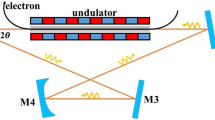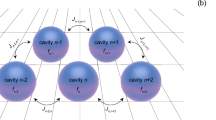Abstract
The Fox–Li integral equation is famous as a simulation method for Fabry–Perot cavities. Three-dimensional and higher-order modes can be easily and precisely calculated using the equation and an ordinary personal computer. Fresnel diffraction is generally used as an optical propagation equation in such approaches. However, when considering an optical microcavity, Fresnel diffraction may not be appropriate because it includes the approximation that the propagation distance is larger than the wavelength. In this study, we applied Rayleigh–Sommerfeld diffraction because it is known to be the exact solution while considering optical diffraction for optical cavities comprising plane mirrors. We calculated the 3D Fox–Li integral equation using the Rayleigh–Sommerfeld diffraction, when the cavity condition differs from the approximation. We obtained the diffraction loss and mode profile and compared them with the numerical solution obtained using the Fresnel diffraction formula. Consequently, the diffraction loss was found to be different when the condition did not match the approximation. However, it was similar in the range with the approximation. We also confirmed that the diffraction loss can be determined by the Fresnel number under all conditions when using Rayleigh–Sommerfeld diffraction. In addition, we investigated the applicability of this method to an actual device such as MEMS-VCSEL. We demonstrate that the Fox–Li method described by the Rayleigh–Sommerfeld diffraction can be applied to various applications for micro-optical devices.






Similar content being viewed by others
References
Larsson, A.: Advance in VCSELs for communication and sensing. IEEE J. Sel. Top. Quantum Electr. 17(6), 1552–1567 (2011)
Suzuki, N., Anan, T., Hatakeyama, H., Fukatsu, K., Yashiki, K., Tokutome, K., Alagawa, T., Tsuji, M.: High speed 1.1-μm-range InGaAs-based VCSELs. IEICE Trans. Electron. 92-C(7), 942–950 (2009)
Moench, H., Carpaij, M., Gerlach, P., Gronenborn, S., Gudde, R., Hellmig, J., Kolb, J. van der Lee, A.: VCSEL-based sensors for distance and velocity. In: Proc. SPIE 97660A-1 (2016)
Mitsumoto, Y., Ooyama, M., Yatabe, C., Kanbara, N.: Laser spectroscopic multi-component hydrocarbon analyzer. Yokogawa Tech. Rep. 56(2), 33–36 (2013)
Khan, M.S., Isamoto, K., Keum, C., Lafitte, N., Totsuka, K., Chong, C., Nishiyama, N., Toshiyoshi, H.: A MEMS tunable VCSEL for scalable SS-OCT, ICO. In: The 24th Congress of the International Commission for Optics, Th2G-03 (2017)
Kanbara, N., Tezuka, S., Watanebe, T.: MEMS tunable VCSEL with concave mirror using the selective polishing method. In: International Conference on Optical MEMS Nanophoton. MA3 (2006)
Yano, T., Saitou, H., Kanbara, N., Noda, R., Tezuka, S., Tezuka, N., Fujimura, N., Ooyama, M., Watanabe, T., Hirata, T., Nishiyama, N.: Wavelength modulation over 500 kHz of micromechanically tunable InP-based VCSELs with Si-MEMS technology. IEEE J. Sel. Top. Quantum Electron. 15(3), 528–534 (2009)
Kitagawa, Y., Suzuki, Y., Saruya, T., Tezuka, K., Kanbara, N., Nishiyama, N.: 1.6 μm to 1.7 µm micromachined tunable VCSELs. In: IEEJ, Sensors and Micromachines the 33rd Sensor Symposium, 24am2-D-5 (2016)
Fox, A.G., Li, T.: Resonant modes in a maser interferometer. Bell Syst. Tech. J. 40, 448 (1961)
Tezuka, S., Kanbara, N.: Stability diagram of higher modes of the Fabry–Perot resonator. Opt. Rev. 15, 1 (2008)
Tezuka, S.: The diagonalization of the 3D Fox–Li integral equation with the Gaussian quadrature formula of very high order. In: 7th International Conference on Optics-Photonics Design & Fabrication, 20PSa-11 (2010)
Born, M., Wolf, E.: Elements of the theory of diffraction. In: Principles of Optics: Electromagnetic Theory of Propagation, Interference and Diffraction of Light, 7th edn., pp. 412–516. Cambridge University Press, Cambridge (1999)
Watanabe, T., Ohuchi, A.: Gauss–Legendre quadrature formula of very high order. Fusion Res. 64(5), 397–407 (1990)
Author information
Authors and Affiliations
Corresponding author
Additional information
Publisher's Note
Springer Nature remains neutral with regard to jurisdictional claims in published maps and institutional affiliations.
Rights and permissions
About this article
Cite this article
Suzuki, Y., Tezuka, Si. Numerical simulation of 3D Fox–Li integral equation described by Rayleigh–Sommerfeld diffraction for MEMS-VCSEL. Opt Rev 26, 430–435 (2019). https://doi.org/10.1007/s10043-019-00551-1
Received:
Accepted:
Published:
Issue Date:
DOI: https://doi.org/10.1007/s10043-019-00551-1




